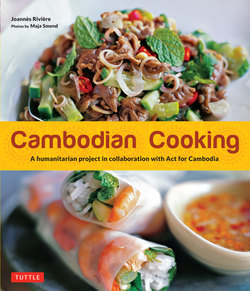Читать книгу Cambodian Cooking - Joannes Riviere - Страница 7
ОглавлениеDiscovering Cambodian Food
Many countries, from China to Vietnam and Thailand, have long shared their national and regional cuisines. Cambodia, however, is almost certainly unknown territory for most of us. Its rural areas are the home of a secret treasure jealously guarded by the families who’ve lived there for centuries—a cuisine that combines authenticity and diversity, simplicity and originality. Now, with this collection of recipes from the young chefs from the Sala Bai School, you have the chance to discover this rich tradition in all its splendor.
Cambodian food is a thousand-year-old tradition. To discover it, you must step back in time to the era of the kingdom of Angkor, the cradle of Khmer civilization, when Cambodian cuisine forged its special identity. Here, cooking is an oral art that has been passed down over time from mother to daughter. It is from this ancestral rite that a traditional cuisine, punctuated by the use of natural ingredients, developed.
Thanks to the influence of other countries, Cambodian cooking has been enriched and expanded over the centuries. China introduced the steaming method and the use of soy and noodles and India introduced curries, to name but two examples. These influences contribute to the particularly wide range of flavors that surprise the palate and stimulate the taste buds. Salty and sweet, and downright bitter and sour, go hand in hand or are blended subtly, sometimes within a single dish, to create a deliciously harmonious and original result.
A Cambodian dish is a feast for the eyes as well as the palate, and the ingredients that compose it are like the colors on a painter’s palette: gleaming red chilies, bright green limes, orange shrimp, flecks of pure white coconut . . . the more harmonious the colors, it is thought, the more subtle the flavor of the finished dish.
Visitors are often surprised by the variety and quantity of fish products on the market in Cambodia. In addition to fresh fish, fish pickled in brine, salt fish, dried fish and smoked fish are also widely available. Fish are ground into complex pastes flavored with spices, crab, sticky black rice, vinegar, sugar and even sometimes unripe papaya. The original purpose of these delicious products was to provide a means of preserving the catch from the two major rivers in Cambodia—the Tonlé Sap and the Mekong. Fresh fish and fish products constitute the main source of protein for many families, and also contain valuable calcium, which is essential in Cambodia as there are no local dairy products.
The recipes in this book are simple and easy to produce. They require little preparation time and don’t involve any complicated techniques. Most of the ingredients can be found in your local supermarket and the more specific ingredients (including suitable Asian substitutes) can be found at the nearest Asian grocery or on-line.
Ingredient alternatives are provided in the Ingredient section (pages 8–11) and helpful tips are given within the recipes. Together, they will help you navigate this culinary adventure and ensure your success.
Basic cooking equipment can be used to cook Cambodian food at home. However, a mortar and pestle is the best tool for crushing whole spices and making spice pastes. Many of the recipes will specify “pounding” ingredients in a mortar and while a food processor is a sufficient substitute, a traditional mortar and pestle makes quick work with little clean up.
The recipes serve four people as a main course, however they can easily be cut in half to yield a smaller quantity or served with other dishes to feed a crowd.
